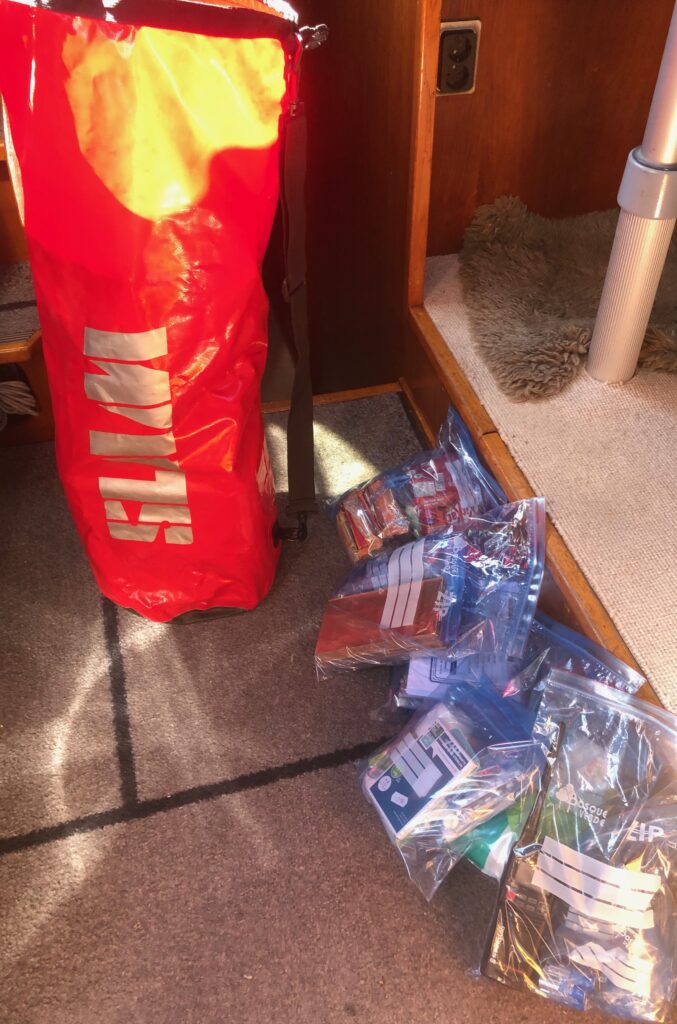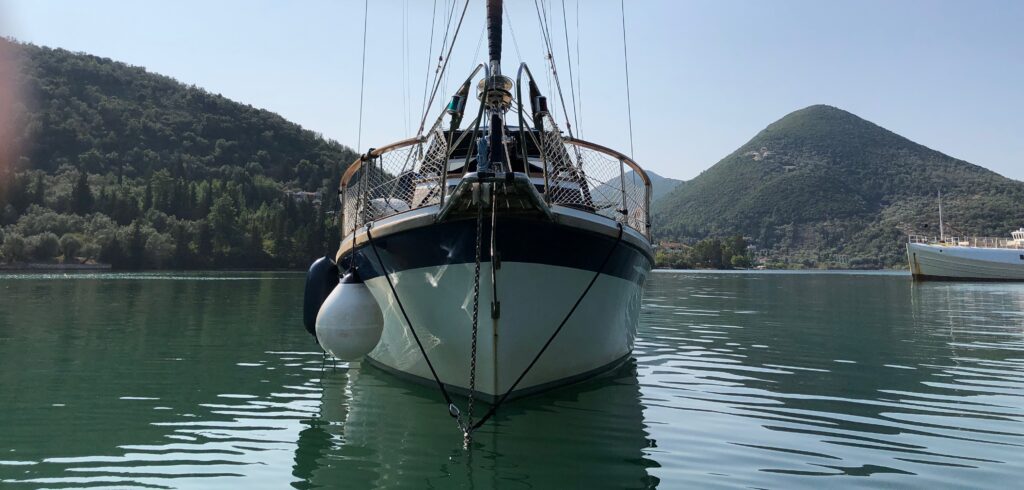Life jackets for children
The parents had bought new life jackets for our grandchildren. We certainly had our own children’s old life jackets on board, but they were 25 years old, so they were probably worn out.
However, the children were a little unsafe in the water, and gradually we began to suspect that it might be because the vests did not behave as we thought. So we had the oldest child test the newly purchased life jacket.
We have the expectation that lifejackets for children must turn the child over on its back so that the head is above water and the child can breathe. That’s the whole idea of the child wearing a life jacket when we sail or they play on the boat bridge.
The parents later complained to the shop where the vests were bought. However, they got nothing out of it, the vests were approved to a standard that does NOT require the child to be turned.
So pay attention to the following standards:
50 N – Swim-ming west
For experienced swimmers near the coast and only with nearby assistance. Not safe in case of unconsciousness.
100 N – Lifejackets
For use in coastal and protected waters. Only limited safety in case of unconsciousness.
These vests are recommended for children! And some of them probably also turn the child around…
150 N – Life jackets.
For use in all waters. Full safety in the event of unconsciousness, however limited safety if heavy, waterproof sailing clothing is worn.
Grap bag

A long-distance sailing boat sank in the summer of 2019 in the Pacific Ocean. The crew had to send a mayday and go into the life raft, but were fortunately rescued by other sailors in the area. Their story of the wreck and their preparations for, what should never happen, but happened anyway, have inspired us (and surely many others) to look at our own safety. In Denmark, we have never had a life raft, we have usually sailed close to the coast and in busy waters and not considered it necessary. As at this time we were on our way to the Mediterranean, which we had intended to cross over a longer distance, we agreed that we must have a life raft. We also talked through the situation and found out that in addition to the life raft we should have a packed grap bag.
When buying a life raft, you must decide whether it must be approved for coastal use or for ocean use (e.g. across the Atlantic). The raft can basically be packed with various things for use in an emergency. E.g. emergency flares, knife, seasickness tablets. It is also possible to order it packed with equipment of your choice. But regardless of what is packed inside, there will be a need for extra things to take with you on the go. Therefore, a bag/container is packed and ready for being brought to the lift raft, a so-called grap bag.
We searched the web to get inspiration for what such a bag should contain. From this we made our list.
The list is OUR best bet on what WE think should be in the bag, it is NOT an approved list and it is only FOR INSPIRATION
The list is intended for Mediterranean cruises, where we will not be more than a day’s sailing away from land. If you are going across the Atlantic, it certainly makes other demands.
| Quantities for 2 adults | In grab bag | Life raft | Packs on the go |
|---|---|---|---|
| First aid and medicine | |||
| sea sickness pills | x | ||
| first aid equipment plaster + gauze | x | ||
| painkillers paracetamol + ibuprofen | x | ||
| sunscreen | x | ||
| vaseline | x | ||
| thermal blankets | x | ||
| Basic survival | |||
| Orange soda with sugar 4 x 1/3 l | x | ||
| water 6 x 1/2 l | x | ||
| 2 bags of dried fruit and nuts | x | ||
| hand pump | x | ||
| ladle | x | ||
| sponge 2 | x | ||
| dishcloth | x | ||
| repair clamps | x | ||
| duct tape + tape that can stick wet | x | ||
| knife | x | x | |
| wet wipes | x | ||
| plastic bags, preferably zip | x | ||
| Equipment to rescue aid | |||
| portable WHF with fresh batteries | x | ||
| extra batteries | x | ||
| flashlight with wind-up | x | ||
| the good flashlight | x | ||
| SOS light | x | ||
| whistle | x | ||
| emergency flares 3 hand-held + 2 parachutes | x | ||
| torch with equipment to transmit Morse code | |||
| mirror | x | ||
| card with rescue signals | x | ||
| throwing line with ring | x | ||
| paddles | x | ||
| Equipment to help afterwards | |||
| photocopy of boat documents incl. insurance papers | x | ||
| copy of passports | x | ||
| passports | x | ||
| wallet with Danish kroner and euros and credit card | x | ||
| our wallets with credit cards etc. | x | ||
| Navigation help | |||
| pencil and paper | x | ||
| compass | x | ||
| phones with gps and map | x | ||
| battery bank | x | ||
| Personal equipment | |||
| reservebriller | x | ||
| solbriller | x | ||
| Kasketter | x | ||
| Nøgler til det derhjemme | x |
Anchor chain marking

We came across the following post on Facebook:
We got tired of constantly thinking about depth, length etc. so we have marked the WATER DEPTH with yellow colour: 3 yellow lines = 3m of water. And we found a more realistic formula than just 7xdepth or 4xdepth:
12*square root(depth)
It takes more into account that the chain hangs. And remember freeboard! We have about 1.5m of freeboard, so at 2.5m of water the depth is actually 4m. So with this formula we have marked the following (in parenthesis chain at the 7xdepth formula):
- 3 yellows (3m water, 4.5m total height) : 25m chain (7xh= 31.5) (In brackets: are we the only ones who lay 25m at 3m water?)
- 5 yellow: 31m chain (45.5m with 7xh)
- 10 yellow: 41m chain (80m with 7xh)
- 15 yellow (15m water) : 49m chain (our nuv Max) (115m with 7xh)
- And in strong winds, we lay out to 1-2m more than the depth.
No calculations while fiddling with anchorage, we just need the water depth.
We have a 44-foot steel boat of 19 tons and must have at least 100 m of chain for long-distance sailing. But has been in England with 16ms constant wind at 8-10m depth with these markings (however laid out for a little deeper and on a good bottom)
It sounded like a really good idea, which we have translated into the following:
The anchor chain is marked according to the current water depth calculated from the following formula, which takes into account that the chain hangs in a parabola:
12*square root (depth+headroom)
Clearance is the height of the anchor roller above the surface. In our case, it is 1.5 m.
Marking is done with blue, split PP cord. Each tag consists of 2 cords (so the marking is still visible if a cord is lost)
| Depth (meters) | Meters of chain | Number of marks |
|---|---|---|
| 3 | 25 | 1 |
| 6 | 33 | 2 |
| 9 | 39 | 3 |
| 12 | 45 | 2 x 2 |
| 15 | 49 | 1 |
| 20 | 56 | 2 |
The table is written with marker on the back side of the anchor well cover, so you just need to know the reading of the depth on the sonar.
If it’s windy, we put a few more meters out. We have a Kobra anchor and a total of 75 m of 10 mm stainless chain for our boat of 13 tons in total. We have set out using this formula in 7m of water in Vliho bay in Greece and at 22m/s we have held both ourselves and another 40ft sailboat lying across our bow.
And then we use two “anchor snubbers” or chain relievers, especially if there is little wind or there is sea.
There is a lot of literature on the subject, an app has also been made for the calculations, which of course depend on hull length, weight and much more, see e.g. here: Ancher chain calculator
